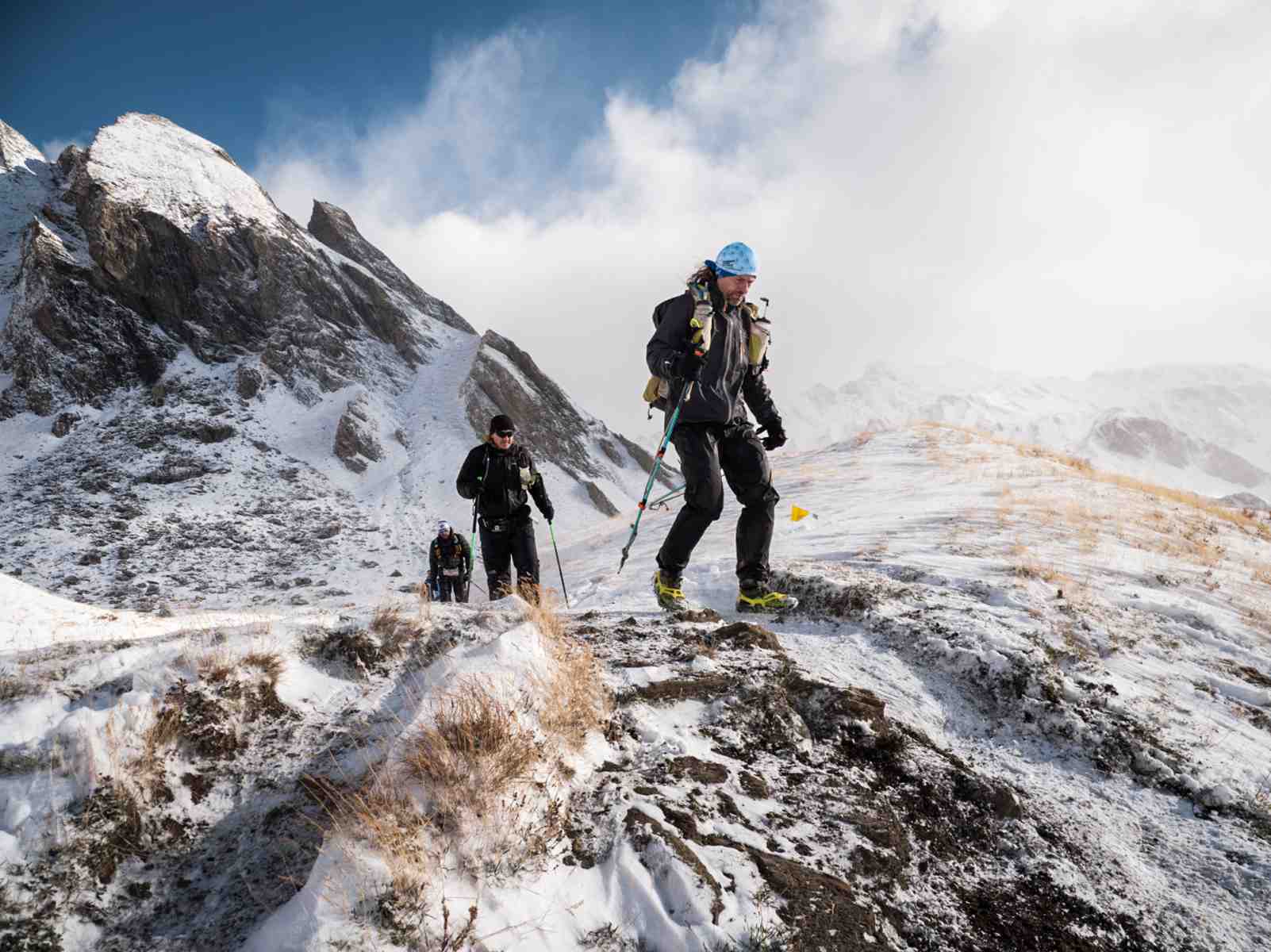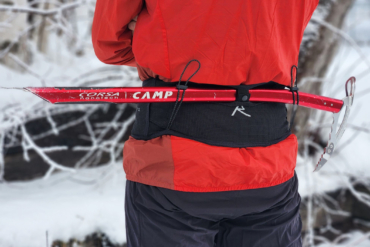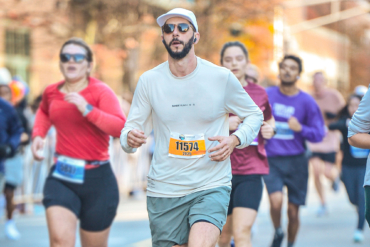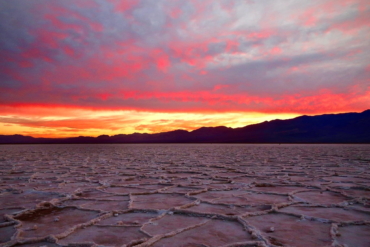Last September, Laura Kaplan found herself high in the Italian Alps running one of the hardest races she’s ever done: the Tor des Géants Ultra Marathon.
This “tour of giants” takes runners over more than 20 mountain passes, past some of the highest peaks in Europe, and through numerous Italian villages. It’s over 200 miles of notoriously difficult alpine terrain, with 75,000 feet of elevation gain. The stunning landscapes in Italy’s Aosta Valley are combined with temperature swings that range from freezing to 80 degrees during the day.
Only about 40% of its 1,200 participants actually cross the finish line in the race’s allotted 150-hour time limit.
Kaplan says the beauty is contrasted by extreme exposure and toughness. It’s why the Tor des Géants is rated as one of the five most challenging ultramarathons on Earth.
“Just one foul step and you’re gonna fall down the mountain,” she said.
But Kaplan’s never shied away from a challenge — the Boulder, Colorado-based runner prides herself on knocking down high-elevation-gain races like Tor des Géants. After being rerouted for the finish of the race due to an impassable blizzard, Kaplan finished.

That was in 2022. Afterward, the ultrarunner swore she’d never run the race again. But this year, Kaplan is going back. And she’s returning with the goal of finishing in the top 10 for women. And two other Boulder-based runners, Nick Stafford and Dan Peterson, are also joining her.
We met up with the athletes to talk about what it takes to run ultramarathons like the Tor des Géants and talk about the gear they’re taking on the journey.
Preparing to Run an Ultramarathon: Tor des Géants

Alpine running and vertical gain are the bread and butter of these athletes — it’s what they enjoy. Training for a marathon like Tor des Géants, Peterson’s strategy is simple: put in “big brutal days.”
“Physically, I’ve been putting in as much vertical climbing as I possibly can,” he said. “So anywhere between 50 and 70 miles, and my goal every week is 30,000 plus feet of gain.”
“Type 2 fun,” he called it. Not so fun in the moment, but fun looking back.
Boulder’s robust trail system is the perfect playground for runners like Peterson, who seek out some of the steepest trails in the area to get as much vert as they can.
“It’s a lot, but I love it,” Dan said.

While Peterson and Stafford are roommates, their training styles couldn’t be more different.
“So I do way less training,” said Stafford, sitting next to Peterson. “I don’t like to think about it like training — I just like to get out and have fun,” he said.
Stafford doesn’t have a regimented training plan. He doesn’t use the running watch Peterson donated to him to track his distance. Instead, Stafford said his strategy is to “just kinda feel it out.”
“I’m usually not as trained as a lot of the other people who do these [ultramarathons],” he said. “So for me, it’s just trying to really go for it on the day, and really push myself to places I don’t normally go.”
That’s not to say Stafford isn’t fit — he keeps up with Peterson when they’re out peak-bagging together in the Rockies. But what he likes most about ultramarathons is competing against himself.
“It’s literally just trying to have a spiritual experience and overcome a lot of adversity and struggle, and trying to make it to the end,” Stafford says.

Stafford excels in his mental toughness, an ingredient Kaplan agrees is key for any ultrarunner.
“Even if you don’t have the fitness,” Kaplan says, “if you can be just mentally strong enough to get through it then you’re going to be successful.”
Kaplan’s own willingness to endure helps her be successful in big races. To train, she tries to get 10,000 feet of vert most days and at least 40,000 feet of vert each week. On top of that, Kaplan also crushes big monthly projects like “Everesting,” the 14,000-foot Quandary Peak, and each of Boulder’s five peaks.
Staying active is top-of-mind for all three of the athletes. If they aren’t running, you’ll find them biking, skiing, scrambling, or climbing to keep their bodies moving.
“Motion is lotion,” Kaplan said, swearing that by staying moving, she doesn’t get aches and pains.
Tapering is an important final piece to prepare for ultramarathons. But many athletes have their own preferences and style for this step. For example, Stafford enters “internal mode” a week before the race without much running to focus on his mental strength, while Kaplan has tried from 2 to 7 days of tapering.
Peterson said the best part of getting ready for a race is all the adventures the preparation will take you on.
“It’s not even all about the actual race,” he says, “it’s like the cliché — it’s [all about] the journey.”
What to Take on an Ultra Marathon
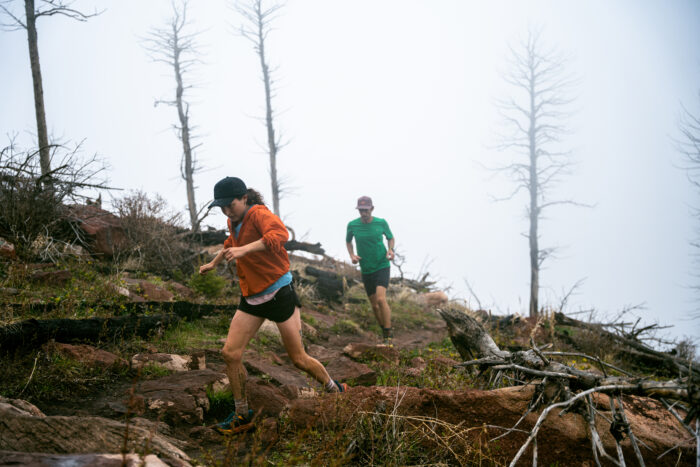
Kaplan’s Gear
(Editor’s note: Kaplan recently started receiving gear support from Arc’teryx)
“I’m honestly a huge gear nerd. This is how I connect with the community,” she said. “The reason why I’ve made so many friends on the trails is because I see what people are wearing … and I literally cannot [stop from asking] them about what they’re wearing and their gear — it’s really bad.”
Waist Belt: Ultimate Direction Unisex Comfort Belt
“I recently fell in love with the [Ultimate Direction] waist belt,” Kaplan said, adding it’s become one of her most important pieces of gear. It helps take weight off her back and she can fit plenty in it, like her phone, chargers, headlamps, and more.
Jacket: Patagonia Houdini
“I don’t think anyone will ever beat the Patagonia Houdini for a wind jacket; it’s like the best ever. It doesn’t matter if it’s winter or summer, you need your wind jacket. It’s always windy no matter what the season is.”
Shoes: Hoka Speedgoat 5
“Originally my go-to shoe was the Salomon SpeedCross 5. But they discontinued it and I hate the Sixes. I’m so mad because it was the best shoe ever.”
Gloves: Outdoor Research Coldfront Down Mittens
“I feel like I’ve tried them all,” she said because she has bad circulation. “And no matter what, my fallback is always the Outdoor Research mittens.”
Stafford’s Gear

“I usually just try to make it work, and don’t put too much energy into optimizing my gear for performance,” says Stafford. “I see people all the time with amazing gear who don’t finish, and then people with horrible gear who do. Don’t get me wrong, better gear will help. But a strong mentality is far more important.”
Shoes: La Sportiva Jackal II BOA
“La Sportiva is known for having grippy shoes that are good for technical terrain. Additionally, these shoes use a BOA lace system, instead of traditional laces. [A] BOA lace system incorporates dials that you can tighten down, instead of tying your shoelaces. I like them a lot.”
Shorts: Patagonia Men’s Strider Pro Running Shorts
“Any shorts will work, but I like ones with a few zipper pockets. Good for storing items, particularly when you don’t have a trail running bag on shorter runs.”
Shirt: Arc’teryx Norvan Tank
“I struggle in the heat of the afternoon, so either a breathable trail running shirt or tank top is a must.”
Jacket: Arc’teryx Alpha FL Jacket
“This one is important, you want something that is lightweight, packable in your bag, but will keep you warm in the cold of the night/wind on the summits of mountains. I definitely recommend not skimping on the jacket, otherwise you’ll pay the price for it.”
Socks: Smartwool Run Zero Cushion Mid Crew Socks
“Any ‘smartwool’ running sock usually works. Good idea to change your socks multiple times in a race to help avoid blisters.”
More Gear:
- Hat: Topo Designs Global Hat
- Running Vest/Pack: Salomon Advanced Skin 12
- Headlamp: Petzl Swift RL Headlamp
- Hiking Poles: Black Diamond Distance Carbon Z Poles
Peterson’s Gear

“I’m a gear junkie myself,” Peterson says. “I spend way too much money on gear.”
Shoes: Hoka Speedgoat 3
“These are the shoes that I wear for all of my ultras. They fit me perfectly and are durable enough to get me through every event. I pair these with a custom orthotic [insole].”
“I have a huge quiver of shoes really. But I like to cycle through my shoes every day. So I’m not running on the same pair of shoes because you’re more likely to get injured that way.”
Shell (Jacket): Montbell Versalite
“Perfect for lightweight and fast adventures with a questionable forecast. Not as waterproof as heavier shells, it’s only a two-layer GORE-TEX, but I haven’t had any issues.”
Socks: Smartwool PhD Running
“These are generally my go-to ultra socks. For me, it’s important to put on a new pair of these every 25 miles. They’re lightweight and thin, which is important when your feet start swelling up after a while.”
Watch: Garmin Fenix 7x SS
“I have loved the watch and its ‘bells and whistles.’ However, should have gotten the Enduro 2 for its superior battery life.”
Shorts: Patagonia Hydropeak Board Shorts
“Boardshorts are my go-to for multiday activities. They can get wet without issue, prevent chafing and are nice to have for going to the bathroom.”
Pack: Salomon Adv Skin X Season 15
“The best running vest I’ve ever used. Fits like the classic Adv Skin 12; however, it’s big enough for long adventures in the mountains.”
Hat: Brookes Propel Mesh
“I bought this a couple of years ago and it is the perfect hat, in my opinion.”
More Gear:
- Sunglasses: Tifosi Swank XL
- Shirt: Arc’teryx Norvan
- Sun Hoodie: Patagonia Tropic Comfort
